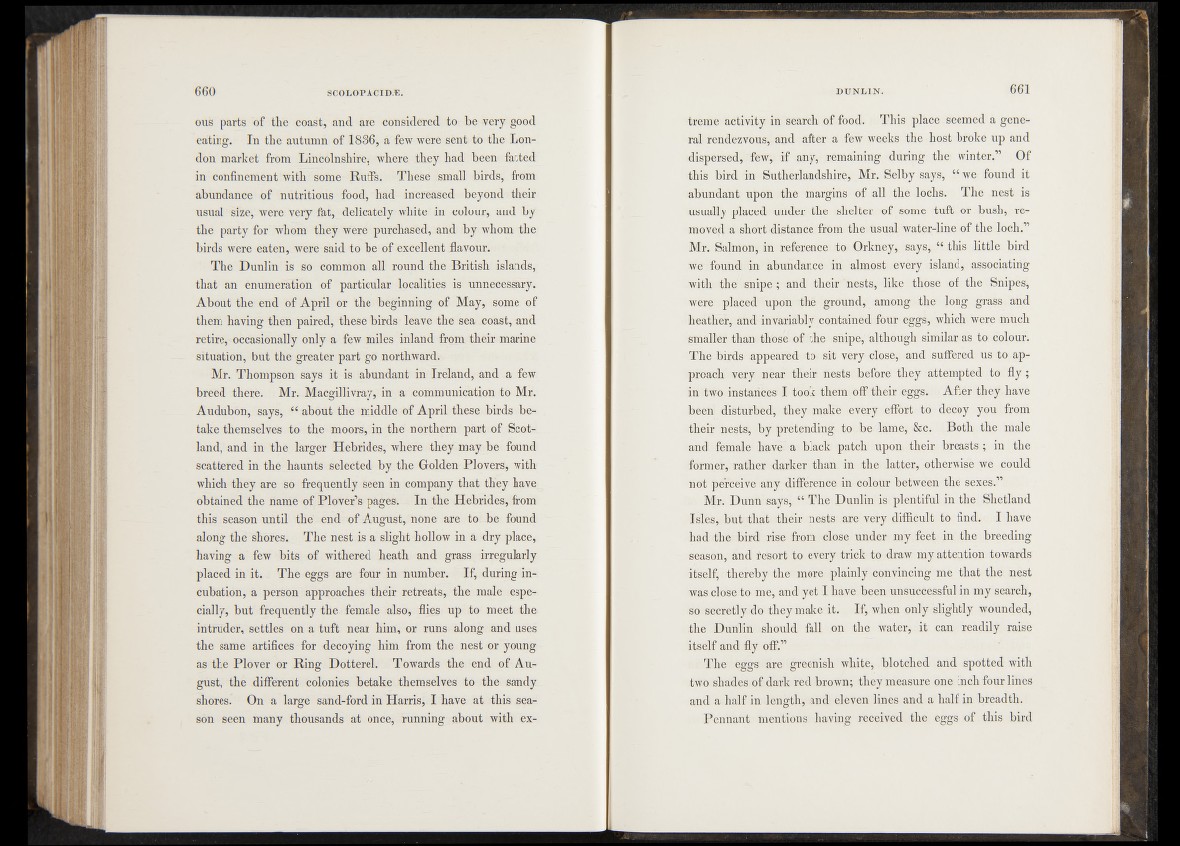
ous parts of the coast, and are considered to be-very good
eating. In the autumn of 1836, à few were sent to the London
market from Lincolnshire* where, they had been fatted
in confinement with some Ruffs. Thêhë .small birds, from
abundance óf nutritious food, had increased beyond their
usual size, were very fat, delicately white in colour, and by
the party for wham they were purchased, and by whom the'
birds were eaten, were said tcfct)e-bf excellent flavour.
The Dunlin is so common all round the British islands,
that an enumeration of particular localities is unnecessary.
About the end of April or the beginning of May, some of
them having then paired, these birds' leave the sea .coast, and
retire,-occasionally only a few miles inland from their marine
situation, but the greater part go northward.
Mr. Thompson says it is abundant in Ireland, and a few
breed there. Mr. Macgillivray,: in a communication jtp Mr.
Audubon, says, (i about the middle of April these birds betake
themselves to the moors,jgn the northern part of Scotland,
and in the larger Hebrides, where they may be found
scattered in the haunts selected by the Golden Plovers, with'
which they are so frequently seen in company that they have,,
obtained the name of Plover’s pages. In the Hebrides, from
this season until the-end of August, none are to~fre found
along the shores. The nest is a slight hollow in a dry place,
having a few bits of withered heath and grass irregularly
placed in it-. ^ The eggs are four in number. If, during in-,
cubation, à person approaches their retreats, the male especially,
but frequently the.- female also, flies up to meet the
intruder, settles oh a tuft near him, or runs along and uses
the same artifices for decoying him from the nest or young
as the Plover or Ring Dotterel. Towards the end of August,
the different colonies betake themselves to the sandy
shores. On a large sahd-ford in Harris, I have at this season
seen many thousands at once, running about with extreme
activity in search, of food. This place. seemed a gene-r
ral rendezvous,, and after a few weeks the host broke up and
dispersed, “few, if any, remaining during the winter.” Of
-this bird in Sutherlandshire, Mr. Selby says, ‘Lwe found it
abundant upon the margins-©f all the lochs. The nest is
usually placed under the shelter of’some tuft or.bush, removed
a short distance, from the*.Usual water-line- of the loch.”
Mr, Salmon, in 'referenceido* Orkney* says/fLth^^Kft^ej; bird
.we-found in abundance* in almost. every islands associating
with-the' snipb'f and their "nests,-like those oföthevSnipes*
were -placed 5 upon ~thè ground, among -the dong, grass and
heather, and-invariably contained four eggS, which were much
smaller than tkbspóf.the snipe,"although similar as to colour.
The birds appeared* d?o t sit very closè,’ and suffered us .to approach
very -near their nestS'&before th^f|aftempted to fly ?
inhtwo instances'L took them-off their, eggs.-.-After thefbha$e
been) disturbed, thé-y^makè every effort to ddcby you from
their nieafes^,biy pretending to .be-lame, &c. Both the male
and female havel^a? black patch, upon their breasts*;- in the
‘former, rather-darker.than, in thenlatter, otherwise we could
not perceive any difference, in colour between the sexes.»” :.
Mr. Dunn says; “ The Dunlin is plentiful in the. Shetland
Isles,'butithat their nests .are'very difficult to find. I h a il
had the'bird rise from close under m'y^ieeL in, the breeding
season, and fesort to* every trick to draw my attention towards
itself,: thereby the morui; plainly icon vincing'me that thU: nést
was cldse tomafe, and'iyetrl, have.been unsuccessful in my search,
so secretly do they make it. | If|when only slightly wounded,
the Dunlin should; fall, on the water,. it can readily raise
itself and fly off.”
rd- Edited eggs', are greenish whitë, blotched and spotted with
two shades.of dark red. brown; they measure one-inch four lines
and a;half in length, and- eleven lines and a half in breadth.
Pennant > mentions having received the eggs of this bird